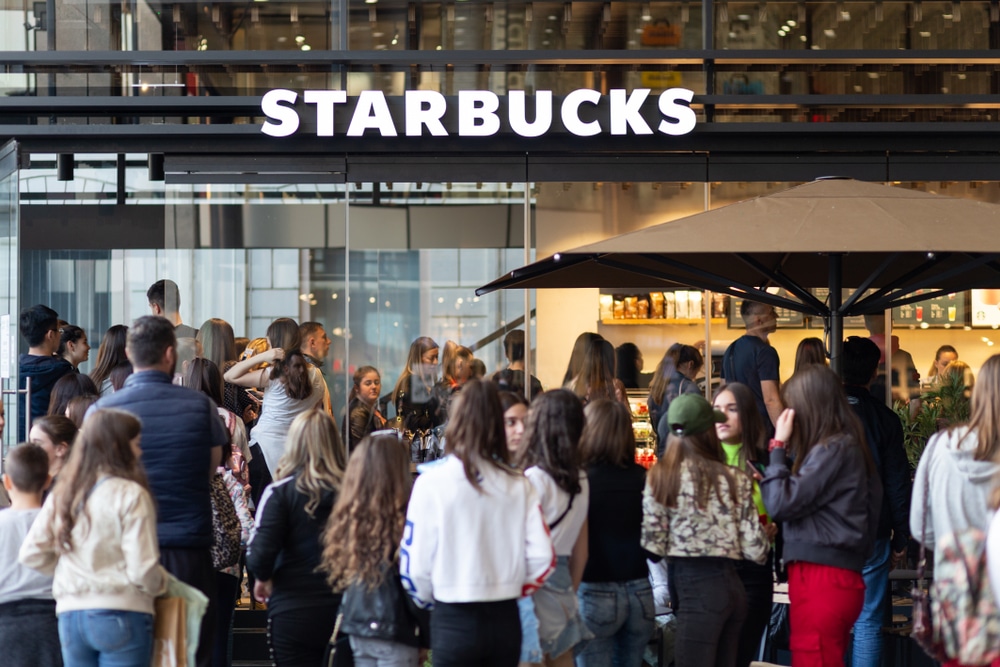When understanding how to build brand affinity, one must understand the difference between loyalty and affinity. Brand loyalty and brand affinity are sometimes used interchangeably, but they really describe two different types of customer relationships. Those with brand loyalty are likely to purchase from you on a rational level. They feel your brand provides some value, but they could still switch to a competitor who appears to offer greater value. A loyal customer may stick with you when your storefront is on their commute home from work, but if he switches to a new job and a new route home, then the loyalty could dissipate. A customer may return to your shop for a sale but then shop the next sale somewhere else.
Brand affinity goes one step further than loyalty to describe those who feel your brand identity aligns with their core values and, in some way, defines them. From Starbucks coffee drinkers and Apple iPhone users to Lululemon yoga pants wearers and Whole Foods shoppers—these people are emotionally connected to their favorite brands and are proud to evangelize their preferences as an aspect of their personalities. When there’s affinity, purchase decisions are likely made on a “feel good” basis, rather than based on logic. Someone with brand affinity will always buy from you, so long as your brand personality remains consistent. Brand affinity can increase conversions by an estimated 131%, so it’s worth pursuing if you want to make your job easier and convert new prospects for life.
The keys to brand affinity are the creation and consistent communication of brand personality. Your brand’s personality is more than a laundry list of traits related to product design and development; it must include core values and messaging that influence how your brand is represented in the world through digital experiences and retail environments.
Why Brand Personality Matters
Establishing a strong brand personality will boost brand affinity, but that’s not all. Brand personality also:
- Breeds consistency and authenticity: There should be no ambiguity over who you are and what you stand for. Your employees should feel proud to work with such a brand. And if all mediums are communicating the same message, consumers are more likely to believe in your legitimacy and trust you as well. By some estimates, consistent brand presentation boosts revenues by 23%.
- Differentiates in the market: Consumers look at (and remember) brands the same way they look at human faces. The typeface, font, colors, characters, and storefront become as familiar as an old friend to your constituents. Shoppers want to associate themselves with charming and memorable brands that attract other people they admire. So often we see family, friends, and coworkers hopping on board with a brand altogether, or we see consumers flocking to brands promoted by influencers and celebrity sponsors.
- Inspires user confidence: Predictability enhances likability. We love our best friends because we know what they like, how they’ll behave, and how they’ll treat us. We love our favorite vacation spots because we know where to dine, where to stay, what to do, how much we’ll spend, and we can almost guarantee a good time. Similarly, knowing how a brand will behave and how it will make us feel makes it easy to decide we like a company.
- Connects with the right customers: Ideally, you want shoppers who frequent your store, spend money, and tell others about their pleasant experience. Compared to new prospects, loyal customers spend 67% more with repeat purchases, larger cart sizes, and frequent upsells. If a first-time shopper has a good experience, they will likely refer three people; by the tenth purchase, that shopper will have referred seven people. This is important because referred customers are 18% more loyal, spend over 13% more, and have 16% higher lifetime values than non-referred customers. Ultimately, you want these people to fall in love with your brand and become your top shoppers.
How to Build Brand Affinity
Consider these three steps to ensure your brand personality is effective:
1. Know the basic ingredients of a winning personality.
Your customers. Sometimes a brand starts with a strong personality and attracts like-minded people. Other times, you can look backward to see who is attracted to your brand and re-define yourself based on the common characteristics of your loyal customer base.
How your brand is perceived. Run a Google search on your brand to see what’s being said. Read forums, news articles, and social media posts to gather important customer insights and competitor analysis.
 Emphasize the traits people universally like. Just as individuals are unique, brands are unique but there are also some common traits everyone must have to be likable. Consumers seek basic brand competence first and foremost. You want to convey that your company is intelligent, reliable, and successful. Next, you want to show that you’re genuine, authentic, honest, wholesome, and sincere; they can trust what you’re selling and the service you’re providing. Thirdly, people like brands that are imaginative, innovative, leading-edge, playful, and spirited; they want to feel excited about your brand and to feel as though they themselves are modernized by affiliating with you. Lastly, shoppers appreciate a certain level of sophistication, charm, and elegance; you don’t have to be James Bond’s watch brand or the Most Interesting Man in the World’s beer, but you want to convey a certain degree of cool that people can’t resist.
Emphasize the traits people universally like. Just as individuals are unique, brands are unique but there are also some common traits everyone must have to be likable. Consumers seek basic brand competence first and foremost. You want to convey that your company is intelligent, reliable, and successful. Next, you want to show that you’re genuine, authentic, honest, wholesome, and sincere; they can trust what you’re selling and the service you’re providing. Thirdly, people like brands that are imaginative, innovative, leading-edge, playful, and spirited; they want to feel excited about your brand and to feel as though they themselves are modernized by affiliating with you. Lastly, shoppers appreciate a certain level of sophistication, charm, and elegance; you don’t have to be James Bond’s watch brand or the Most Interesting Man in the World’s beer, but you want to convey a certain degree of cool that people can’t resist.
2. Consider what different personalities appeal to consumers.
Once you have the basics down, you can consider what specific dominant characteristic you’d like to convey. There can be different aspects of your brand personality conveyed through different campaigns, too, but here are some of the archetypes commonly employed by brands:
- The Lover: These sensual brands ooze mystical charm, exuding passion, sophistication, and glamor. They appeal to luxury buyers who want to be seduced and intoxicated with a brand. (ex: Chanel)
- The Explorer: These rugged brands are thrill-seekers, pushing themselves to the limits, focused on achievement, and centered on adventure and self-fulfillment. (ex: North Face)
- The Sage: These wise brands are looking to educate, derive satisfaction from knowledge, fancy themselves intellectual thought leaders, and pride themselves on innovation. (ex: Google)
- The Jester: These playful brands are cheery, thrive on the weird and fun, and are inclusive in their silliness. Their chief goal is to lighten the mood and bring entertainment through laughter. (ex: M&Ms)
- The Ruler: These dominant brands want to be noticed, admired, and lead the world. They exude wealth, respect, prestige, and power. (ex: Rolls Royce)
- The Magician: These spellbinding brands delight in the enchanting journey toward what’s possible, rather than what “is.” They believe where there is a will, there is a way, and that dreams really do come true. (ex: Disney)
- The Caregiver: These safe brands are generous providers that want to feel loved and cherished by their customers. They take great pride in providing service, going the extra mile to help, responding with compassion, and selflessly protecting. (ex: Huggies)
- The Innocent: These down-to-earth brands are sincere, non-offensive, risk-averse, transparent, and simple. You can count on these brands to spread optimism, positivity, and kindness. They do things the good-old-fashioned way. (ex: Dove)
- The Everyman: These regular brands don’t require any bells and whistles; they’re friendly, helpful, relatable, humble, and inclusive. They take pride in a job well-done with no fuss or muss. (ex: Levi’s)
- The Hero: These determined brands have the courage to stick with the path to progress. They appeal to self-confident winners who are looking for bold, inspiring ways to change the world. They’re enduring champions of the people. (ex: Duracell)
- The Creator: These creative brands are trendsetters who march to a different drum. They attract customers who fancy themselves unique, avant-garde, and artistic. They create their own reality based on a stand-out vision. (ex: Apple)
- The Outlaw: These rebellious brands are mavericks who operate outside normal conventions. They do what they want, how they want, and thrive on breaking traditions, opposing authority, and challenging the norm. (ex: Harley Davidson)
3. Use the latest technology to communicate brand personality.
Knowing how to build brand affinity through personality is the easy part; the bigger challenge comes in consistently conveying your brand identity to customers. Brand development is a continuous process of reiterating your message and evolving with your customers’ needs and preferences. You need to meet your shoppers in the channels where they’re spending most of their time. Technology offers plenty of opportunities for connecting and reconnecting with your customer base. Traditional media like TV, magazine, billboard, and radio advertising are still around, but increasingly, blogs, social media, banner ads, and mobile advertising are taking precedence, as they are more affordable ways to communicate.
Knowing how to build brand affinity through personality is the easy part; the bigger challenge comes in consistently conveying your brand identity to customers.
Shopkick, the #1 most engaging shopping rewards app, is another option for brands looking to convey their personalities to shoppers where it matters most—in the store, at the shelf, at the moment where a purchase decision is about to take place. App users shop for nearby deals on their smartphones. When entering a participating store offering rewards, users can earn “kicks” for simply walking in, which they can then use toward a free gift card of their choosing. They can also earn points by scanning a particular brand’s products, watching videos, flipping through lookbooks, and making select purchases. Brands can build affinity by offering unique, informative, and engaging content by partnering with Shopkick.
Want more ideas for building brand affinity? Check out what Shopkick has done for our partners. Contact us to learn how easy it is to get started building brand-specific content for loyal Shopkickers!
Image courtesy of Dalibor Co.





